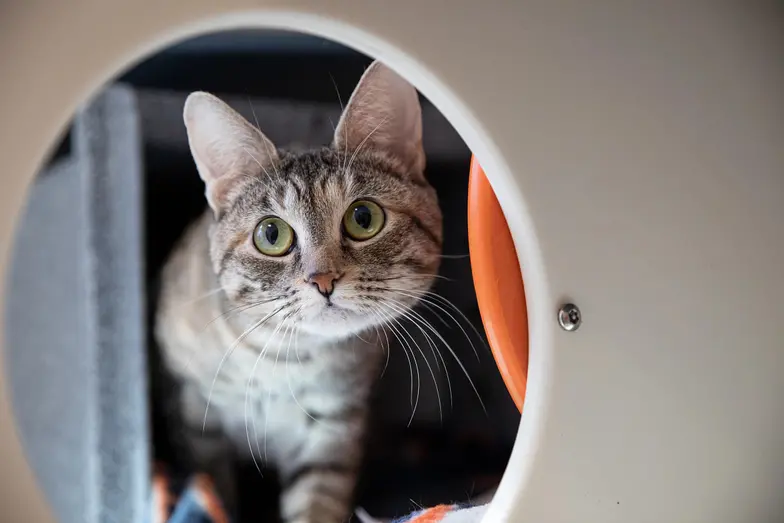Feline Upper Respiratory Infection

Feline upper respiratory infection (URI) is a contagious disease that spreads easily and commonly occurs in animal shelters, rescues, and foster homes. Feline URI is often associated with stressful conditions due to overcrowding, lack of humane housing, poor sanitation, and increased length of stay. Treatment of feline URI requires staff time, shelter resources, and further increases cats’ length of stay.
The majority of feline URI cases are caused by calicivirus and herpesvirus. Feline calicivirus can be periodically shed by recovered cats and survive up to a month in the environment. Feline herpesvirus often causes a latent infection after initial illness and can be reactivated in stressful conditions, making it challenging to control the spread in shelter environments. Additionally, bacterial infection of the respiratory tract may occur in cats affected by such viruses.
Other causes of feline URI include Chlamydophila felis, Bordetella bronchiseptica, and Mycoplasma species.
Prevention
Feline URI is best managed in shelters by minimizing its occurrence through:
- Providing humane housing
- Decreasing stressful conditions (See Fear Free Shelters.)
- Reducing length of stay
- Utilizing good sanitation practices
- Administering appropriately timed FVRCP vaccines (Feline Viral Rhinotracheitis, Calicivirus, Panleukopenia)
Although the FVRCP vaccine contains herpesvirus and calicivirus components (as well as panleukopenia virus), the vaccine does not prevent feline URI, viral shedding, or the development of a carrier state. However, vaccination may reduce the severity and duration of clinical signs associated with feline URI.
Modified live vaccines (MLV) are preferable to inactivated vaccines because they induce more rapid protection. All cats should be vaccinated at or before entry to a shelter.
- For adult cats, the vaccine should be repeated 2 weeks later.
- For kittens, the first vaccine should be administered no earlier than 4 weeks of age and then every 2 weeks until 16-20 weeks of age.
- Additional information is available in the Vaccination Recommendations for Shelter Cats download and the Medical Health section of the ASV Guidelines for Standards of Care in Animal Shelters.
Clinical Signs
Clinical signs of URI include:
- Fever
- Depression
- Decreased appetite
- Conjunctivitis
- Discharge from eyes/nose
- Sneezing
- Dehydration
- Additional signs can include oral ulceration, skin lesions, limping (commonly associated with calicivirus) and corneal inflammation or ulceration (commonly associated with herpesvirus)
Daily monitoring of affected cats is vital to assess whether clinical signs are improving or worsening. Immediate veterinary attention is needed if the cat exhibits the following:
- Open-mouth breathing
- Increased respiratory effort
- Lying on its side and cannot be roused
- Pale or grey oral mucous membranes
Transmission
Feline URI easily spreads in shelter environments via fomites (objects that carry infectious agents from one animal to the next) including hands, scrub tops, stethoscopes, toys, and shoes. Feline URI can also be transmitted by droplets over distances of 5 feet or less, but aerosol transmission does not play a major role in spreading URI. The agents that cause feline URI are generally not transmissible to humans.
Diagnosis
In shelters, a diagnosis of feline URI is based on presence of associated clinical signs, and additional diagnostics are not typically necessary. If more cats than usual are affected or experiencing severe signs, additional testing to determine specific pathogen(s) involved is justified. A RT-PCR test can be performed to determine the presence of feline respiratory pathogens. However, some agents (e.g., herpesvirus) can be present and detected in clinically normal cats due to a recent vaccination and the RT-PCR test can detect these. Given these testing challenges, a shelter may need to test multiple cats to better understand the role of various pathogens. If an affected cat dies or is euthanized, sending the cat’s body for necropsy with histopathology can be valuable in determining a diagnosis.
Treatment & Management
A veterinarian with knowledge of shelter medicine and familiarity with the shelter’s population should oversee the examination, diagnosis, and treatment of affected cats. Having feline URI protocols developed by a veterinarian can empower trained staff to identify and treat routine cases in a shelter or foster environment.
Therapy is initiated based on the severity of clinical signs:
- If a cat only has clear discharge from eyes or nose, they may only need supportive care (feeding palatable food, wiping mucus from nose prior to feeding, providing good air quality, and ensuring adequate hydration).
- If a cat has green or yellow discharge from nose or eyes, a veterinarian may prescribe oral or ocular antibiotic therapy.
- If a cat is dehydrated, administration of subcutaneous fluids is helpful.
Additional information regarding therapy can be found in the sample Feline URI Treatment [PDF] resource. With concern for the development of antibiotic-resistant bacteria, judicious use of antibiotics to treat feline URI is warranted.
If a significant portion of a shelter’s cat population is suffering from URI (i.e., 10% or more), it is time to review feline housing, capacity for care, stress reduction strategies, and vaccination protocols. The ASPCA’s Shelter Medicine Services team is available to provide consultations and assistance.
Resources and Downloads
- Vaccination Recommendation for Shelter Cats [PDF]
- ASV Guidelines for Standards of Care in Animal Shelters (Medical Health section)
- Feline URI Treatment How-To [PDF]
- Cleaning & Sanitation for Animal Shelters
- Population Management in Animal Shelters
- URI Protocol for Kitten Foster Programs
Last Reviewed November 2023
